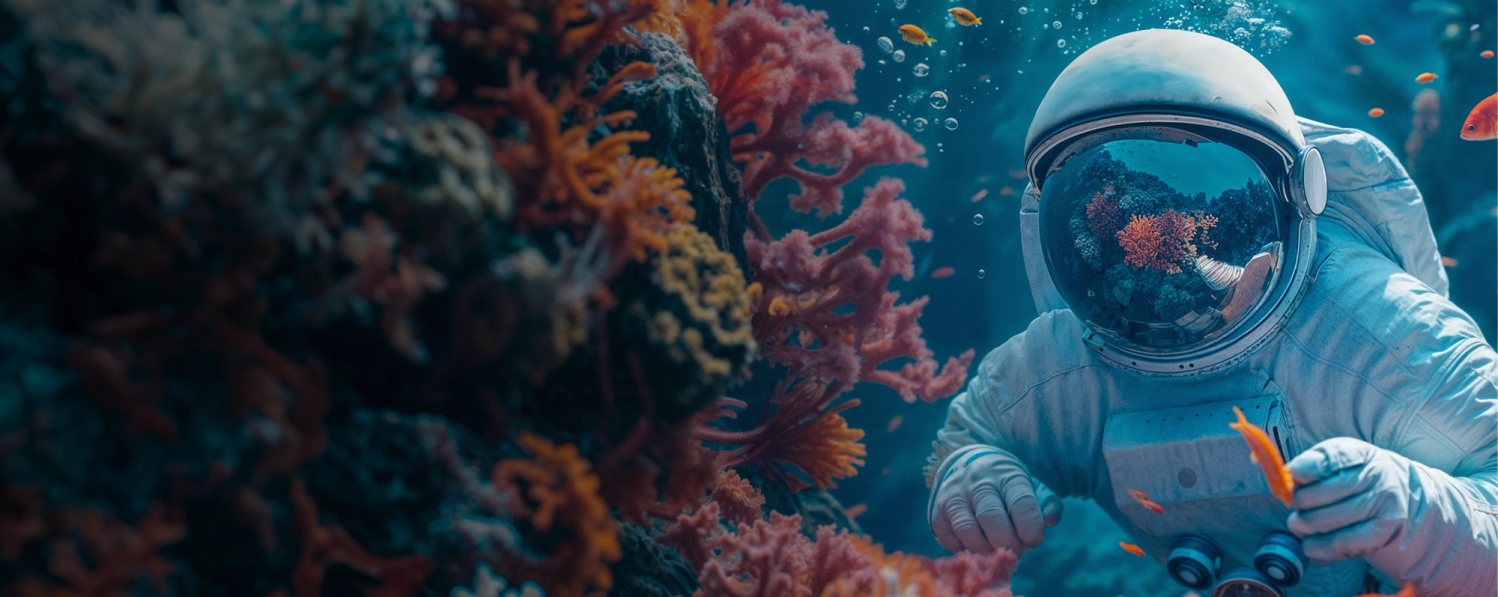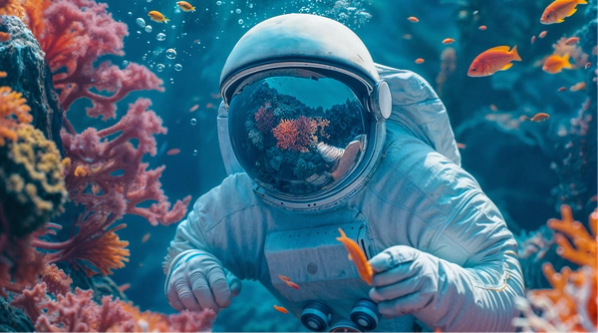
How to Unlock New Market Opportunities With 3D and AR
Published 16 Apr, 2024
Think 3D and AR are gimmicks? Think again, These immersive technologies are opening up new market opportunities across everything from retail to gaming to real estate. But while they can help drive brand awareness and conversions, they also have their challenges. We break down the opportunities and what you can do to take advantage of these experiences today.
When it comes to using augmented reality (AR) and 3D in marketing, it’s not a question of whether you should try it—it’s why you haven’t yet. 3D and AR technologies are no longer just icing on the cake for campaigns. They are now critical ingredients marketing leaders use to craft some of the most memorable experiences for consumers and businesses alike.
The growth of 3D and AR market opportunities isn’t slowing down either. Gartner predicts that worldwide immersive tech spending will grow by 6.8% this year alone.
We’ve had a front-row seat to see how businesses are using 3D and AR to supercharge their campaigns. Thanks to our global team of AR, 3D, and design pros, Superside has helped over 35 brands unleash their 3D and AR capabilities.
So, what can you do to take advantage of these 3D and AR market opportunities? We asked Superside's Motion and 3D Creative Director, José Teixeria, for his insights on what you need to know to unlock new opportunities with 3D, AR and AI.
How 3D and AR Work Together
AR is more than overlaying text or simple images onto the real world. Adding 3D models to AR experiences gives audiences personalized, immersive experiences that can capture their imaginations and attention.
Whatever your industry, putting 3D and AR together can help you create deeper, longer-lasting connections with customers.
Teixeria explains that users are now more enabled and connected than ever before, hungry for new information. Moving into the future, 3D is the essential solution for brands as consumer experiences become increasingly immersive.
3D serves as the foundation for AR, and immersion is the bridge between users and the augmented reality experience. It also plays a vital role in AI technologies. With the ability to generate AI video already in place, the next step is creating 3D environments from AI videos, enhancing the sensation of full immersion.

Combining 3D and AR allows for:
- Enhanced product visualizations. From trying on new kicks to seeing how a sofa fits in your living room, 3D and AR modeling can reduce friction points along the buyer journey.
- Interactive customer experiences. 3D and AR modeling can take your customer experiences to new levels with personalized storytelling wherever they happen to be.
- Multidimensional marketing and branding. Whether it’s interactive marketing campaigns, gamified experiences, or branded filters, 3D and AR are the perfect power couple to captivate audiences and drive brand awareness and loyalty.
Step Into 3D and AR Design Excellence With Superside
How much impact do 3D and AR have when it comes to brand awareness and loyalty? In a consumer survey by NielsenIQ, 61% of respondents said they preferred to shop with retailers that offer AR experiences.
It’s not loyalty, either. One of the most significant impacts of AR seen by B2C and B2B businesses is its impact on conversion. AR market opportunities are reshaping the buyer journey by building trust faster.
E-commerce leader Shopify reported that merchants using AR for product visualizations experienced a 2x increase in conversions. 3D is generating equally impressive numbers. According to a report in VentureBeat, interactive 3D marketing campaigns can generate a 40% increase in conversions.
We’ve seen these results in action when we deliver immersive 3D and AR experiences with traditional creative assets for our customers’ campaigns. 90% of brands reported triple the brand lift when combining AR ads with traditional media, while businesses utilizing 3D design see a 40% increase in conversion rates.
In the world of 3D, assets are highly reusable. This means that within a brand's ecosystem, the value and return on investment (ROI) of created assets can increase over the lifespan of the branding. By simply adjusting colors, camera angles, or adding new assets, a wealth of possibilities emerges with just a few 3D objects.

Superside offers a modular, agile and cost-effective subscription solution to help you deliver on your marketing strategies. Included with your subscription is a team of some of the world’s most talented 3D and AR creatives.
One of our favorite examples is using 3D and AR to make the invisible visible. Doodle Labs is a leader in the development of industrial-grade wireless networking solutions. They needed a novel way to demonstrate how their mobile radio technology helps drones gather mission-critical information.
We used the 3D design tool Spline to demonstrate how drones used Doodle Labs’ mesh radio technology. Viewers could see where the mesh radio signals were and how the drones interacted with those signals.
How to Unlock New Market Opportunities With 3D and AR
As we mentioned before, campaigns that convert are using 3D and AR in tandem with traditional assets. They’re an extension of the experience that can help you increase conversions and raise brand awareness. Plus, AR is just fun to experience—especially when it’s done right.
In today's technological user ecosystem, all companies benefit in some way from using 3D in their communications, marketing, and, when applicable, prototyping processes. People react differently to 3D, and movement enhances this reaction even further. With the opportunity for spatial interaction and immersion, 3D and AR make brands more dynamic.

Meta AR Specialist Dan Moller shared his thoughts on AR at our Virtual Summit last year. Dan said that he often gets asked if AR is still too gimmicky. He told the summit’s audience that gimmicky is not a way he’d describe AR. According to Dan, Meta has over 750 million people using AR effects each month.
We already have approximately 750 million people on Meta platforms using AR effects every single month. Of these users, 78% return and utilize them monthly or more, while a total of 35% of Meta platform users engage with AR. The market is anticipated to grow like crazy, highlighting its powerful scalability potential.

Here are six ways businesses are unlocking new opportunities with 3D and AR.
1. Interactive advertising campaigns
Reading social copy or watching a short video can have an impact, but they’re one-way conversations with your audience. Interactive advertising campaigns built with 3D and AR technologies create personalized experiences that engage your audiences. These interactive campaigns use the sensors and cameras in a mobile device in a browser, all without the need for a custom-built application. No downloading means one less point of friction.
Sony Pictures created an AR-powered experience leading up to the release of Jumanji: The Next Level in 2020. Movie fans were directed to a website via social posts to explore the world of Jumanji. The experience was one of the first voice-activated AR experiences, letting fans say things like “buy tickets” to bring them to the online box office.
Regarding 3D, we at Superside took on the challenge of refreshing Boomi's lead generation ads while adhering to a tight budget. Boomi, a leader in cloud-based integration services, needed its ads to match its new branding and stand out with creativity and wit. Drawing from Boomi's past branding, our 3D team proposed a bold and innovative campaign featuring sharp copy and eye-catching 3D visuals. This approach aimed to bring a modern and dynamic feel to Boomi's ads, ensuring they grabbed attention in the competitive tech market.
2. Virtual events and experiences
Virtual events have come a long way in the last four years. Gone are the days of sitting passively and watching people speak to a camera. Today’s virtual events use everything from breakout rooms to interactive polls to AR to bring people deeper into the event experience.
Whether you’re hosting a virtual conference or launching a new product, 3D and AR technologies can help you make your attendees feel like they’re part of the show.
In 2022, Nike launched SWOOSH, an immersive platform for users to learn, collect, and co-create interactive digital objects. Fans were able to create and share virtual shoes and jerseys and “wear” them in immersive experiences.
For 6Sense's flagship event, Breakthrough, Superside teamed up with 6Sense to create an innovative AR experience. The project transformed 6Sense's 5-step campaign execution method into an interactive Instagram filter, involving detailed work such as updating illustrations, adding 3D modeling and animation. The outcome was a carefully crafted and engaging AR guidebook.
3. Product visualization
One of the biggest drawbacks of online shopping has always been the unknowns—how will this shirt fit, how do these shoes look with my jeans, or even does this fridge fit in my kitchen? AR has changed that by enabling consumers to try on or try out products in their spaces.
Source: Home Depot
Home Depot developed an AR feature for its mobile app to let customers see products in their homes before buying. The home improvement leader reported that its product visualization feature boosted conversion rates by two to three times over customers who did not use the app.
AR has also helped brands reduce costly returns. Macy’s reported that return rates dropped to under 2% for furniture purchases made using its AR visualization feature. For comparison, the industry average is 5-7%.
4. Real estate and architecture
3D and AR are also shaking up the world of real estate marketing. Realtors are using AR to give potential buyers virtual walkthroughs of properties from the comfort of their living rooms. It's like a sneak peek behind the curtain without ever leaving home!
Like trying on shoes or looking at furniture, AR is having an equally exponential impact on real estate conversions. One recent report showed that realtors using AR for property marketing have seen a conversion increase of up to 40%.
Home buyers can use an app like the Street Peak Realtor App to get instant information on a property, including how many bathrooms, value, and even neighborhood information. Architects can even use 3D and AR to help them bring flat blueprints to life. RealAR revolutionizes the architectural landscape by offering architects a powerful tool to bring their visions to life. RealAR enables architects to immerse themselves and their clients in a virtual version of their dream home. 3D rendering allows viewers to even see how light and shadow can change throughout the day before drywall is even ordered.
5. Gaming and entertainment
Gaming is one of the first use cases most people think of when they AR, mainly due to the seemingly unending popularity of Pokémon Go!. The mobile game got millions of people off their couches and into the real world to catch and battle with friends and neighbors. The game was launched in 2016 and is still one of the most downloaded games for iOS and Android smartphones.
Source: Pokemon
But AR doesn’t stop at gaming—even with Pokémon. The Pokémon Company created the Pokémon Smile AR app to help teach children how to brush their teeth properly. Guided by fan favorite Pikachu, children brush away bacteria while catching up to 100 Pokémon.
The PGA TOUR used AR to bring a new experience to on-site fans at 12 TOUR events. Its AR-enabled app brought the best parts of the home-viewing experience to the golf course, letting fans see instant replays right on the greens. App users could also review player stats and scores and even overlay the arc of their favorite player’s drives.
The potential of 3D in gamified platforms extends to the enhancement of user engagement and immersive learning experiences.
Superside helped MyTrees, a gamified platform that rewards eco-friendly behaviors like walking instead of driving with tree plantings and cash rewards, to develop a playful and inviting brand identity. Starting with the logo and color scheme, the collaboration expanded to include character illustrations, which evolved into anthropomorphized versions of inanimate objects to enhance the brand's appeal. This creative approach was carried through to the design of MyTrees' landing pages, app interface and pitch decks, featuring a mix of 3D shading and flat 2D styles to make the brand both fun and accessible.
6. Retail and e-commerce
We looked at how these immersive technologies are improving product visualizations, but that’s just the tip of the 3D iceberg. 3D and AR are opening up new opportunities to connect, retain, and convert customers like never before possible.
71% of shoppers said that they would shop more often if a retailer offered AR experiences. If you think that’s impressive, then how about this—40% of consumers said they’d pay more for a product if they could experience it through AR before buying.
One of the earliest—and best—examples of AR in retail is from our friends in Sweden at IKEA. The lifestyle furniture company was one of the first brands to use 3D and AR for e-commerce. Customers can view 3D models of KALLAX shelves, MALM dressers, and STRANDMON chairs in the IKEA app, but that’s not where the experience ends. Using AR, customers can see how IKEA’s furniture will fit into their spaces before they make the drive to their nearest IKEA store. The only thing missing are the Swedish meatballs.
Untangling Complexity in 3D and AR Challenges
3D and AR are game-changing technologies for marketing and advertising, but they also come with some complexities and challenges. Delivering on your campaign goals means understanding these challenges and having the right support—internal or a Creative-as-a-Service subscription—to help you develop the assets you need.
3D and AR are merely tools with added layers of complexity. Therefore, today, businesses can seamlessly access these services at scale through companies like Superside. We have strategists to assist customers with their vision and a wide range of specific requests and challenges to address.

How Superside can help you get started and get the most from using 3D and AR:
- Optimizing 3D models. Optimizing for performance and quality is paramount in AR development. Unlike traditional 3D models displayed on a screen, AR models must seamlessly integrate with the real world and adapt to various environments and devices. Balancing performance and visual quality is crucial to delivering compelling AR experiences.
- Development costs. The cost of developing AR apps or experiences varies significantly and depends on factors such as complexity, features, and platform compatibility. If you need 3D modeling of objects, those costs can rise significantly.
- Development time. The development timeline for 3D and AR projects can be extensive, with creating 3D models taking over eight weeks and AR app development spanning up to six months.
Solving these challenges is where Superside comes in. We can create multiple versions of 3D assets for digital ads, videos, and performance marketing campaigns that match your brand’s other assets. From your website to printed materials, social graphics to motion graphics, Superside’s team can scale to meet your campaign needs.
Mapping the Future: 3D and AR Market Predictions
Combined with its cousin technology, virtual reality (VR), the market for AR and VR is expected to grow from $25.1 billion today to over $71 billion by 2028. The 3D market is seeing equally impressive numbers. The 3D animation market reached $17.21 billion in 2021 and is on a project path toward $46.89 billion by 2030.
What trends are driving these predictions? Here are a few that we are keeping our eyes on:
1. The dynamic duo of AR and AI. Personalization is the secret sauce behind many of the leading AR experiences. Advancements in AI and machine learning (ML) are predicted to help drive even more personalized experiences. According to IDC, AI integration in AR experiences will give brands new ways to deliver interactive experiences with more natural and intuitive user interfaces.
Strong AI Vision technologies integrated into light AR headsets and AI digitalization tools will open up a world of constant spatial computing, opening up the external physical world as a digital billboard for brands.

2. AR in the cloud. Like almost every technology, there’s a cloud for AR. The technology gives AR developers and designers a digital copy of the real world to build and test AR experiences before deploying to users. This technology enables the creative of deeply localized experiences for everything from shopping to sporting events and more. Verizon says the AR cloud market could reach $2.6 billion this year alone.
We are at the very beginning of the futuristic AR revolution but it seems inevitable as we approach peak performance of all the tools needed to open up this space. Brand guidelines can expand beyond assets and motion into spatial computing guidelines, offering insights into how brands are experienced spatially. With today's technology, this transition is feasible and only requires momentum to reach the next stage.

3. AR and 5G. There hasn’t been a technology with more hype without real-world examples like 5G. But 5G’s low latency and high bandwidth cellular technology seems like it was almost designed for 3D and AR. Delivering immersive experiences like 3D and AR takes a lot of processing on the smartphone and in the cloud. 5G provides the bandwidth and speed needed to help make these experiences feel seamless to users. 5G and AR are predicted to drive the AR market to $12.3 billion this year.
Now, you know staying ahead of the curve is important, but not every business has the internal team and resources to build the 3D and AR elements needed for their campaigns. 3D and AR are also quickly evolving technologies, and understanding and implementing these advancements is crucial to remain competitive.
Delivering these 3D and AR experiences at scale is another challenge. AI is one way to help scale asset creation, but again, getting the right skillsets on your team can be time-consuming and costly. Superside's AI-enhanced creative teams can help your work more quickly and cost-effectively, in many cases up to 60% faster.
Breaking Boundaries by Embracing 3D and AR With Superside
3D and AR are as natural to marketing as video, motion graphics, and great copy. Today’s audiences are looking for deeper connections, more interactive experiences, and personalized touches. This is exactly what 3D and AR deliver.
The market opportunities are there, but developing AR and 3D for your marketing campaigns has its challenges, from optimizing models for performance to managing development costs and timelines.
Teixeira explains why Superside is well-positioned to fulfill this supplier role at scale because we have deep expertise and a diverse creative team to support the entire process:
3D and AR/VR experiences don't happen in isolation; they still heavily rely on design during pre-production. Luckily, we have top-notch talent across the board. Our design and illustration team offers a wide range of styles, our UI&UX team is operating at full capacity, and our 3D and AR teams are highly effective and efficient. They all work together seamlessly, continuously improving our production pipelines.

Having experts in-house isn’t always an option. Superside can help you overcome these challenges with our global team of experts. We want you to unlock the full potential of 3D and AR to elevate your brand, drive conversions, and build long-lasting customer loyalty.
As the future of marketing continues to evolve, embracing 3D and AR with Superside positions businesses to lead the way in innovation and seize the limitless opportunities that lie ahead.
Alex is a freelance writer and newsletter aficionado based in Waterloo, Ontario. When he’s not writing for clients, he’s putting together TL;WR, a weekly culture and events newsletter his mom says is excellent. Alex has worked with some of Canada’s largest tech companies in PR, marketing and communication roles. Connect with him on LinkedIn to chat or get ideas on what to do this weekend in Waterloo.














